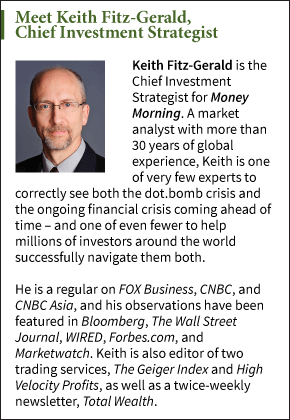Alternative investments are one of the fastest-growing asset classes right now.
The amount of money put into alternative investments grew by 19% last year, according to a May 2015 report from advisory firm Money Management Institution. London-based research firm Preqin had growth at 11% in 2014 to $7 trillion -- differing slightly from MMI data, but likewise a huge increase.
And according to the U.S. Securities and Exchange Commission in April, the alternative mutual fund market (funds that use non-traditional investments and trading strategies) grew from about $76 billion in assets at the end of 2009, to more than $311 billion in assets by the end of 2014.
Here's why investors are turning to alternative assets to preserve and grow wealth...
Alternative Investments: Risks vs. Rewards
Diversifying outside the major markets can mitigate portfolio risks, especially in times of economic crisis.
"With one eye on the recovery and one eye on the monster that may surface from under their beds, investors have gotten a lot more interested in alternative investments," Money Morning Chief Investment Strategist Keith Fitz-Gerald said on June 15. "They've always been there as an asset class so that's not unexpected. But what's new is the understanding of the role that they can play in turbulent times."
Alternative investments offer investors certain upsides:
- A hedge against the swings of the larger markets. In other words, alternative investments are less prone to volatility "despite the fact they seem riskier than traditional assets," Fitz-Gerald said.
- Portfolio diversification.
- A way to play the market when stocks are overvalued.
- An exciting way for passionate collectors to make money.
 Still, Fitz-Gerald warned, where there are rewards, there are also risks to navigate.
Still, Fitz-Gerald warned, where there are rewards, there are also risks to navigate.
"More interest in alternative investments is good because most investors have historically ignored alternative investments. But it's also bad because investors often have an overly narrow view of what an alternative investment can be," Fitz-Gerald said. "Too many investors view commodities as the only type of alternative investment, and commodities can be every bit as volatile as the overall markets - and sometimes even more so. In reality, there are all kinds of investment-grade products ranging from art, to wine, to stamps and even my personal favorite, classic motorcycles."
"The 1960s vintage E-Type Jags I grew up appreciating for $15,000 a copy, can now fetch more than $150,000 at auction. There's no question they have a unique appreciation potential."
They also have unique risks, Fitz-Gerald warned. "You never want to buy because something's a good 'deal.'"
Some risks posed by alternative investments are as follows:
- Markets for alternative investments are typically more difficult to track compared to traditional markets.
- Storage and insurance pose additional hurdles for tangible alternative investments.
- Illiquidity can be a problem compared to the relative liquidity of stocks, bonds, and cash.
Now that you know the advantages and the risks, let's take a look at five alternative investments in detail...
A Closer Look at Five Alternative Investments
Alternative Investments No. 1: Real Estate
Real estate is a common alternative investment that offers the opportunity to own property. Typically, investor(s) lease a structure to tenants in return for income and the potential for capital gain upon the sale of the property.
Because of its low correlation to other asset classes, real estate is an excellent portfolio diversifier. It also serves as an inflation hedge -- real estate returns are linked to rent received from tenants. And because real estate is a tangible asset, investors have a greater degree of control over its performance (renovation, improvements, choice of tenant, etc.).
A downside is real estate investing generally requires a large initial investment. Transaction costs are high, and almost all real estate assets require management.
Alternative Investments No. 2: Commodities
Another of the most popular alternative investments, as we mentioned before, are commodities. An investment in commodities represents a direct investment in raw materials such as:
- Precious metals (typically gold, silver, platinum, copper)
- Oil
- Natural gas
- Wheat
- Chocolate
- Sugar
Some investors buy and sell the physical commodities themselves, like oil or gold producers. However, most investors use options, futures, or ETF markets to get involved. Commodities markets offer price tracking without the burden of trading the underlying commodities themselves.
Because commodities are real assets (unlike stocks and bonds), they typically rise alongside inflation, making them a great inflationary hedge. Like all alternative investments, they are portfolio diversifiers.
Now let's take a look three niche alternative investments that are ruled by nothing more than simple supply and demand...
Alternative Investments Nos. 3, 4, and 5: Art, Watches, and Motorcycles
Investing in collectibles is, in many ways, simpler than investing in anything else. It all comes down to supply and demand and having intense knowledge of a particular niche.

Collectibles are typically portable and can be traded anywhere in the world. Plus they tend to gain capital value above the inflation rate. Disadvantages include danger of fraud and potential difficulties obtaining a buyer when you want to sell quickly.
Art as an investment hit headlines on May 11 after Christie's New York sold Pablo Picasso's masterpiece "Les Femmes d'Alger" for $179,365,000 -- making it the most expensive painting ever sold at auction.
"Art is something you invest in because you like it," Fitz-Gerald said. "Established masters are pretty easy to understand and value. Of course, buying today's artist on the grounds that he or she is tomorrow's Picasso is tough."
[epom key="ddec3ef33420ef7c9964a4695c349764" redirect="" sourceid="" imported="false"]
While the chance of becoming an overnight art-investing billionaire is rare, investors who can't afford a masterpiece price point should not be discouraged. Michael Moses, president of Beautiful Asset Advisors and creator of the Mei Moses Fine Art Index, tracks repeat art sales (sales of the same object over a period of time) as an indicator of how the art market is doing. Mandel told Wealth Management on March 6 that the data of 45,000 repeat sales showed an average compound return of 6.5% to 7% annually. The best returns were in low-price-point works in the $25,000 to $50,000 range. He said masterpieces, in fact, tend to underperform.
Watches also have a worldwide market. According to Edward Faber, a watch dealer with New York's Aaron Faber Gallery who spoke with The Wall Street Journal along with our own Fitz-Gerald, a Rolex with the proper paperwork "can be taken to any major city in Russia, South America, India, and now China and turned directly into cash."
"Provenance and packaging is critical," Fitz-Gerald said. "The better and more you've got, the more your watch is worth."
He warned that fakes make the watch market risky, and so inspection is essential.
Of course, of all alternative investments of the collectible-type, Fitz-Gerald's personal favorite is one he has great passion for: motorcycles.
"We have some art, swords, and other collectibles, but you can't ride the former nor use the latter," Fitz-Gerald said.
He noted specific models and years matter greatly, and early models from makes like Harley, Vincent, and BMW are particularly sought after.
"In some cases, a complete restoration is a valuable undertaking. In others, the patina is desirable," Fitz-Gerald said. "My 1977 BMW R100RS is a great example. First production year, limited number still in existence, and special engine and design features. It's kind of a holy grail for bike collectors."
Tweet the author @TaraKateClarke.
Precious Metal Investing: Money Morning Resource Specialist Peter Krauth sees 2015 as a good year for silver. To find out just how far he sees the white metal heading, check out his 2015 forecast...
Related Articles:
- WealthManagement.com: Art as Investment
- Wall Street Journal: So You Think You Want to Invest In...


